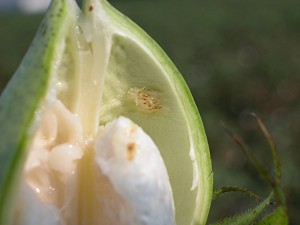Along with the rains in many areas has come a rise in insect pest pressure in cotton. The bollworm flight, although not especially large, has begun across the state. Plant bugs, both tarnished and clouded, and stink bugs are also being reported in many areas and especially in the “greener” cotton. These next two weeks will be crunch time for insect control.
When to Treat:
- Treat when 4 or more bollworm or tobacco budworms are found per 100 plants. Don’t get too excited about egg lays less than 20-30% or finding a few small worms in Bt cotton. The Bt technologies usually hold up well to light and moderate bollworm pressure. However, thorough scouting is a necessity, and treatment will be more likely if the flight occurs over an extended period of time.
- Treatment is recommended if a field averages 3 or more tarnished plant bugs per drop cloth. I prefer the drop cloth over the sweep net once cotton is in full bloom.
- Count clouded plant bugs as equivalent to 1.5 tarnished plant bugs. They are more likely to feed on bolls and more damaging on a per insect basis than tarnished plant bugs. Fortunately, they are easier to kill.
-
Several approaches can be used to make treatment decisions on stink bugs. When mixed with plant bugs, you can count 1 stink bug as equivalent to to 3 tarnished plant bugs. Or you can make decisions based on the injury observed to quarter or thumb-sized bolls, treating when 15-20% of bolls show internal evidence of feeding.
- Once cutout is reached, it takes 350 DD60s or about 18-21 days depending upon the temperature until control of many insect pests can be terminated. Generally, fields not at threshold for plant bugs, stink bugs and bollworm can be “cut loose” at this time. Spider mites can still pose a potential threat for another 200-300 DD60s.
Cutout is defined as having 5 or fewer nodes above the uppermost first position white flower. With recent rains, some fields on the edge may ride 5 nodes above white flower for a couple of weeks, in which case you start the clock when it drops below.
Insecticide Options:
- I’ve been consistent over the years that beginning in mid July most insecticide treatments should include a pyrethroid component. The pyrethroids provide good control of stink bugs and protection from bollworms that are often in the mix. One of the many bifenthrin products such as Brigade, Fanfare or Discipline are preferred if brown stink bugs are common.
- I almost always recommend a tank mix with the pyrethroid insecticide. The pyrethroids by themselves are typically not good enough on tarnished plant bugs, but they work well in combination with other insecticides. We sometimes get good enough control with bifenthrin if it has not been used previously, but I still like the mix. There are many economical tank mix options. Orthene/Acephate (0.33 – 0.5 lb ai/acre), Bidrin (2-4 oz per acre), Vydate CL-V (6-8 oz/acre), Diamond (4-6 oz/acre) and Dimethoate (6-8 oz/acre) have performed well in my tests. There are some premixes out there that also have a fit; Bidrin XP II and Endigo come to mind as premier performers. Transform is also an option for plant bugs but will need to be tank mixed or used as part of a rotation if bollworm or stink bugs also require treatment.
- If bollworms pressure is high (or tobacco budworm in non-Bt cotton), there are some new but relatively pricy products to consider. Prevathon (16-24 oz/acre) provides excellent residual control. Besiege contains the same active ingredient (rynaxypyr or chlorantraniliprole) as Prevathon but is premixed with lambda-cyhalothrin (the active found in Karate). Its typical use rate is 8-12 oz/acre. Belt SC (2-3 oz/acre) and some older chemsitries such as Tracer (2-2.9 oz/acre) and Steward (9-11 oz/acre) are other good options. Keep in mind that Prevathon, Belt SC, Tracer and Steward provide little or no control of plant bugs and stink bugs.
What Not To Do:
- Quit too early. I’ve was hearing a lot about giving up when drought was killing us, but with the recent rains, we need to protect what looks to be a pretty decent crop in most places.
- Don’t use just imidacloprid (Admire Pro, Couraze, Wrangler, etc.). These products are weak on stink bugs, mediocre on mid-season plant bugs, and provide no protection against bollworm. I know it is cheap, but it must be tank mixed to provide acceptable control. Leverage 360 is a premix of beta-cyfluthrin (a pyrethroid) and imidacloprid. Use it at the full rate of 3.2 oz/acre. Brigadier (bifenthrin + imidacloprid) is another premix that I would recommend at 7 oz/acre.
- Don’t forget spider mites. Rainfall takes stress off the plants and helps them tolerate spider mites, but they can rebuild to a problem quickly. People tend to underestimate their potential impact, and I am still getting calls.



One thought on “Cotton Insect Action Increases”
Comments are closed.